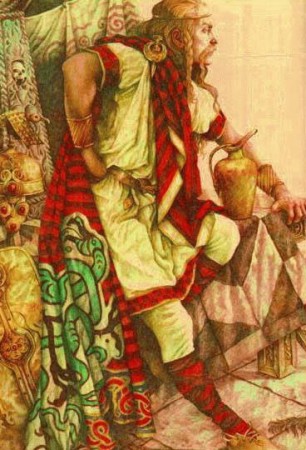Irish Werewolf Cub-Scouts from Hell? January 26, 2011
Author: Beach Combing | in : Ancient, Medieval , trackbackIrish werewolf cub-scouts from hell… Sounds like a bad slasher film doesn’t it? But actually Beachcombing is about to introduce a genuine all singing, all dancing early medieval Irish institution. His first reading is from the Annals of Ulster for AD 847 ‘the sack of the island of Loch Muinremair by Mael Sechnaill [Irish High King] against a large fian-band of sons of death of the Luigni and Gailenga [two Irish tribes] who had been ravaging the tribes in the manner of the pagans’.
And who were the fian? Well, the word is familiar in the modern English word Fenian used today and, indeed, since the eighteenth century for Irish patriots/terrorists prepared to use violence in the pursuit of a united and independent Eire. However, that was just a modern borrowing from the original Fennians, the war band of Fionn Mac Cumhaill, a legendary figure from Irish antiquity who ranged over the Irish wilderness with a band of merry outlaws: think a visceral, no-holds-barred version of Robin Hood.
What is not generally known is that the Fionn legends are, in turn, the mythic reflex of a real institution. Young Irish men very often left their tribes in late adolescence to spend a couple of years out in the wilderness in gangs. It all sounds rather like a modern School in the Wood or Centre for Steinerian Creativity or, damn it, the Cub Scouts until you find out what they got up to.
They would change their name, run around naked and challenge each other to kill a non Fennian – rape is also reported in some instances. Think Lord of the Flies practised on the tribe that had, at least for a while, let its youngest members go.
When they returned to society all would be forgiven and their families would have gained hardened warriors, experienced in wilderness living.
These young vagabonds get a bad press not least because it was the Church in medieval Ireland that wrote things down: and the Church naturally did not approve. But we have some glimpses of life from their point of view.
What about this gloss – actually a charm – in a ninth-century manuscript? ‘wolves and deer and mountain wandering and young warriors of the fian.’
Or here is a king remembering his time out in the wilds as a young man:
I would slay a boar, I would follow a track when I was alone, I would march against a band of five when I was one of five, I was prone to ravage when I was one of ten, I was prone to raid when I was one of twenty, I was ready for battle when I was one of a hundred. Those were my deeds!
What a life! Beachcombing is already zipping up his overnight bag, reaching for his Massai spear and trying to book a plane to Donegal.
But what of the werewolves? Well, wolves come up again and again in relation to these murderous Fennian scamps. The charm above is an example or the following intriguing passage that seems to describe an ex-Fennian:
‘he was a man who used to go wolfing, i.e. into wolf shapes, he used to go and his offspring used to go after him and they used to kill the herds after the fashion of wolves.’
Similar customs operated across ancient tribal communities from Ireland to India – the old Indo-European continuum. It is possible that, for Arcadia in central Greece, a memory of this is to be found in the Roman author Pliny reporting the Greek writer Evanthes: there is an Arcardian tradition
‘that a man chosen by lot from the family of one Anthus is escorted to some marsh in the area. He hangs his clothes on an oak tree, swims across the marsh, goes off into the wilderness, is transformed into a wolf, and joins a pack with others of the same kind for nine years. If he has held himself back from human flesh in that time, he returns to the same marsh, swims back across it, and recovers his form, with nine years’ aging added to his erstwhile guise’.
Perhaps the origins of the werewolf legend are to be found in these customs that only survived in the corners of Euro-Asia by the time that written records were established? Young men go out to become ‘wolves’ for a number of years as a rite of passage, the bloodiest gap year imaginable. Any other werewolf explanations: drbeachcombing AT yahoo DOT com



